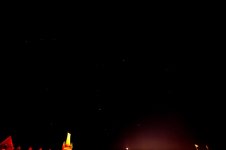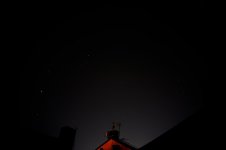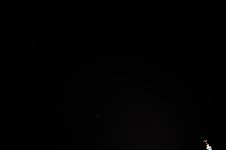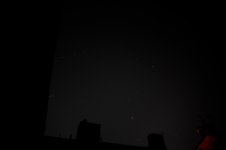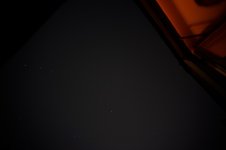No Penguins hurt...
A polar bear with a penguin on its chest is now circling the Earth in a polar orbit!
It's a zero-g indicator on the Fram2 mission: https://www.space.com/space-explora...oats-as-fram2-zero-g-indicator-in-polar-orbit
I think that must be Jupiter and, below, Aldeberan in Taurus looking West... a good warmup... nice to see that people in Sweden value proper FM aerials.
I'm trying to figure out all the 75 half wave dipole and 300 ohm folded dipole stuff and whether I need a matching Balun for my 75 ohm FM tuner, The internet and eBay is the usual mass of muddled advice.
I have forgotten it all, which is embarrassing because I used to call myself a Telecoms Engineer, but my indoor aerial has finally disintegrated... 😳
My plan for tomorrow, Wednesday 19.50 UTC, which is 20.50 BST and 21.50 CEST in Sweden is to snap the eclipsing binary star Algol at minimum (dropping mag 2.1 to 3.4) in the North West:
https://skyandtelescope.org/observing/the-minima-of-algol/
It's going to be a tricky effort with the twilight, light pollution and near full Moon against me. Easier in Sweden I think. It lasts an hour either side apparently.
I took this snap a week ago low in the back garden about the same time and Algol, Beta Persei is bottom left. Above is the main drag of Perseus. I'll probably go to the Common for a better view.

Prior planning prevents **** poor performance. The 6 Ps!

https://theskylive.com/jupiter-info
The main pointers will be Jupiter, Aldeberan and Capella in Auriga. Algol is making a nice isosceles triangle with Jupiter and Capella, so I know where to point the camera.
f3.5, ISO 1600 and 4 seconds I would think. But I usually bracket some exposures. A minor wonder... fanciful people call it "The Demon Star". 🤣
I'm trying to figure out all the 75 half wave dipole and 300 ohm folded dipole stuff and whether I need a matching Balun for my 75 ohm FM tuner, The internet and eBay is the usual mass of muddled advice.
I have forgotten it all, which is embarrassing because I used to call myself a Telecoms Engineer, but my indoor aerial has finally disintegrated... 😳
My plan for tomorrow, Wednesday 19.50 UTC, which is 20.50 BST and 21.50 CEST in Sweden is to snap the eclipsing binary star Algol at minimum (dropping mag 2.1 to 3.4) in the North West:
https://skyandtelescope.org/observing/the-minima-of-algol/
It's going to be a tricky effort with the twilight, light pollution and near full Moon against me. Easier in Sweden I think. It lasts an hour either side apparently.
I took this snap a week ago low in the back garden about the same time and Algol, Beta Persei is bottom left. Above is the main drag of Perseus. I'll probably go to the Common for a better view.
Prior planning prevents **** poor performance. The 6 Ps!
https://theskylive.com/jupiter-info
The main pointers will be Jupiter, Aldeberan and Capella in Auriga. Algol is making a nice isosceles triangle with Jupiter and Capella, so I know where to point the camera.
f3.5, ISO 1600 and 4 seconds I would think. But I usually bracket some exposures. A minor wonder... fanciful people call it "The Demon Star". 🤣
Last edited:
"The Demon Star"
You're such a tease, Steve!
I read that early stargazers may have associated the star Algol's variable brightness with the evil, winking eye of the Medusa.
"Algol is an eclipsing binary star. This type of star is composed of two stars, with each star revolving around the other. From Earth, we see the orbital plane of this binary star almost exactly edge-on. Therefore, when the dimmer of the two stars swings in front of the brighter star, we see Algol at minimum brightness."
More information and a nice animation of an eclipsing binary star may be found in this link: https://earthsky.org/brightest-stars/algol-the-demon-star/
I really think all this Mythology stuff should be dropped. It is also the complete timewaster in Patrick Moore's book. I have similar views about all the boring history of Quantum Mechanics and Relativity.
Now THIS is interesting. The series expansion of e. It's a beauty because it is so easy to differentiate. No other function does this. Which is how Schrodinger's two wave equations get so tidy.

What is amazing is that x can be almost anything. Change it to negative or purely imaginary, even matrices, and add or subtract the series, and you get about half of the interesting maths in the Universe, and most of the useful stuff:

For instance, Orbits, Quantum Mechanics and Relativity. I may get back to this...
To answer TNT's noobie question, we are looking at 2150 CEST in Sweden, about two hours after sunset low in the North-West, though it is just an hour after sunset here.
As ever, prior planning is the key. You really ought to be able to identify Jupiter, Capella and Aldeberan. The rest is geometry. Chance of a trial run tonight too.

Something should still be seen up to an hour either side.
Now THIS is interesting. The series expansion of e. It's a beauty because it is so easy to differentiate. No other function does this. Which is how Schrodinger's two wave equations get so tidy.
What is amazing is that x can be almost anything. Change it to negative or purely imaginary, even matrices, and add or subtract the series, and you get about half of the interesting maths in the Universe, and most of the useful stuff:
For instance, Orbits, Quantum Mechanics and Relativity. I may get back to this...
To answer TNT's noobie question, we are looking at 2150 CEST in Sweden, about two hours after sunset low in the North-West, though it is just an hour after sunset here.
As ever, prior planning is the key. You really ought to be able to identify Jupiter, Capella and Aldeberan. The rest is geometry. Chance of a trial run tonight too.
Something should still be seen up to an hour either side.
Last edited:
I read that the Mclaurin [sic] series mentioned above are named after the Scottish mathematician Colin Maclaurin (1698-1746). 😎

Maclaurin introduced the method of generating conic sections that is named after him and discovered "a whole host of new curves never before discussed and which have since been named and investigated with but scant acknowledgment of their true inventor".
He extended Newton's work on calculus, geometry and gravitation, and it was on Newton's recommendation that Maclaurin was made a professor of mathematics at the University of Edinburgh in 1725.
https://www.britannica.com/biography/Colin-Maclaurin#:~:text=Colin Maclaurin (born February 1698, Kilmodan, Argyllshire, Scotland—died,entered the University of Glasgow at age 11.
Maclaurin introduced the method of generating conic sections that is named after him and discovered "a whole host of new curves never before discussed and which have since been named and investigated with but scant acknowledgment of their true inventor".
He extended Newton's work on calculus, geometry and gravitation, and it was on Newton's recommendation that Maclaurin was made a professor of mathematics at the University of Edinburgh in 1725.
https://www.britannica.com/biography/Colin-Maclaurin#:~:text=Colin Maclaurin (born February 1698, Kilmodan, Argyllshire, Scotland—died,entered the University of Glasgow at age 11.
I think a lot of people knew about these series in the early days of calculus, but I was distressed to hear Colin Maclaurin fell off his horse when fleeing the Jacobite uprising, which was IMO the usual worst combination of Politics and Religion, and developed "Dropsy" which is horribly swollen legs and feet, sign of a heart problem, you would think, and died as a result at a young 48.
I didn't have much luck with my Algol rehearsal in the twilight at 2050, but 2120 was much better and it's the brightest one below middle:

Mars in Gemini nearly lined up below Castor and Pollux moving towards the Beehive Cluster on the left in the quadrangle of stars of Cancer. But the Moon next month spoils the shot when it is dead centre.

So that went well. Just went in the back garden. 🙂
I didn't have much luck with my Algol rehearsal in the twilight at 2050, but 2120 was much better and it's the brightest one below middle:
Mars in Gemini nearly lined up below Castor and Pollux moving towards the Beehive Cluster on the left in the quadrangle of stars of Cancer. But the Moon next month spoils the shot when it is dead centre.
So that went well. Just went in the back garden. 🙂
Yes I think you got that little triangle of stars in Image 1 and also 5 right above the chimney. Making a triangle with Jupiter and Capella too. But the chimney pots are HORRIBLE and must be avoided I think. More exposure needed too, or is that processing?
The Moon and high cloud mucked up my picture of the Beehive, I realised. But a good rehearsal. Tomorrow will be a cinch.
The Moon and high cloud mucked up my picture of the Beehive, I realised. But a good rehearsal. Tomorrow will be a cinch.
Would you mind painting in one of my pictures and point out the triplet in question please 😉
//
//
I have the advantage of having avidly read Patrick Moore's Observer's Book of Astronomy from a young age. Anyway, this is your first image annotated:

I've just realised your wide-angle lens has also got Mars, Pollux and Castor in Gemini in the top left too. I'm not sure brightness/contrast processing is helping your cause here.
I was up at 5.10 today, an hour before sunrise and Vega in Lyra was high up:

Apparently, Beta Lyrae is another variable, around 3.5- 4.2, which isn't a lot except it is sometimes as bright as Gamma and sometimes the faintest of the 4 stars in the main trapezium of 4 stars.
Epsilon to the left of Vega is an easy genuine double.

The way this 12.9 day variable works is twice a fortnight, it dims appreciably, so with 13 nightly observations it can be nailed. Which is more than I can say for the wretched Nova, which was a blank as usual.
I might even have an old picture on a backup USB stick, because 13/1 is good odds.
I've just realised your wide-angle lens has also got Mars, Pollux and Castor in Gemini in the top left too. I'm not sure brightness/contrast processing is helping your cause here.
I was up at 5.10 today, an hour before sunrise and Vega in Lyra was high up:
Apparently, Beta Lyrae is another variable, around 3.5- 4.2, which isn't a lot except it is sometimes as bright as Gamma and sometimes the faintest of the 4 stars in the main trapezium of 4 stars.
Epsilon to the left of Vega is an easy genuine double.
The way this 12.9 day variable works is twice a fortnight, it dims appreciably, so with 13 nightly observations it can be nailed. Which is more than I can say for the wretched Nova, which was a blank as usual.
I might even have an old picture on a backup USB stick, because 13/1 is good odds.
Last edited:
Ah, "The Black Cat in the Coal Cellar" shot! I can't pull your camera settings off that image, but can see Mars, Jupiter, Capella and Algol (right). Also the Pleides with some effort.
But I would guess this is underexposed.
I usually use f2.5, ISO 800 and 4s, and it is the time that I maximise for my longer focus lenses (Here 35mm) because the Earth moves and 4s is 1 arcminute, which is about the closest double I can resolve.
Epsilon Lyrae is 3 arc seconds, for instance, so easy enough.
In this case I started with f2.8, ISO 800 and 4s. But that was too much in the twilight with a full Moon, so changed to f3.5, which is also sharper as a bonus. This is on manual M settings.
This twilight factor reduced what I can do. I think you need more exposure here. Last night was our reference shots, so this matters. We want the same setup on both, ideally.
The 6Ps... 😛
But I would guess this is underexposed.
I usually use f2.5, ISO 800 and 4s, and it is the time that I maximise for my longer focus lenses (Here 35mm) because the Earth moves and 4s is 1 arcminute, which is about the closest double I can resolve.
Epsilon Lyrae is 3 arc seconds, for instance, so easy enough.
In this case I started with f2.8, ISO 800 and 4s. But that was too much in the twilight with a full Moon, so changed to f3.5, which is also sharper as a bonus. This is on manual M settings.
This twilight factor reduced what I can do. I think you need more exposure here. Last night was our reference shots, so this matters. We want the same setup on both, ideally.
The 6Ps... 😛
Last edited:
I believe it was: FF (6D) - 20mm 3,5 - 4s - ISO 1600.
Postprocessing: (disregard actual histogram, but levers as used) - out of care it was like 17% gray perhaps.. i.e. fairly light...

//
Postprocessing: (disregard actual histogram, but levers as used) - out of care it was like 17% gray perhaps.. i.e. fairly light...
//
Surely if the exposure is right, it needs no processing? Now stacking pictures makes sense to improve signal to noise. But I am happy so far.
Set 35 mm camera lens to 4s, ISO 800, f3.5, Noise Reduction on. Put pencil marks on lens to mark infinity focus...a trick I have learned.
AND NOW, THE MOMENT YOU HAVE ALL BEEN WAITING FOR.... Algol drops from 2.1 to 3.4.... which is about 1/3 the brightness.
8 April 2025, 2120 Hrs BST.

9 April 2025, 2120 Hrs BST.

Algol, Alpha Persei at top, and to the bottom right Gamma Andromeda are normally the same brightness between 1.8 and 2.1. Everything else is magnitude 3 or fainter.
The star Rho just below Algol is mag 3.3.

I think I'll try and avoid the twilight and full moon next time.
Set 35 mm camera lens to 4s, ISO 800, f3.5, Noise Reduction on. Put pencil marks on lens to mark infinity focus...a trick I have learned.
AND NOW, THE MOMENT YOU HAVE ALL BEEN WAITING FOR.... Algol drops from 2.1 to 3.4.... which is about 1/3 the brightness.
8 April 2025, 2120 Hrs BST.
9 April 2025, 2120 Hrs BST.
Algol, Alpha Persei at top, and to the bottom right Gamma Andromeda are normally the same brightness between 1.8 and 2.1. Everything else is magnitude 3 or fainter.
The star Rho just below Algol is mag 3.3.
I think I'll try and avoid the twilight and full moon next time.
Last edited:
- Home
- Member Areas
- The Lounge
- Does this explain what generates gravity?
